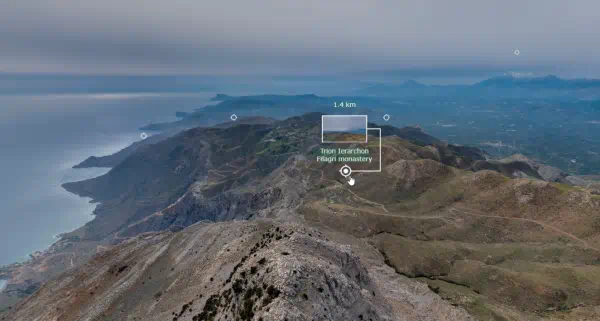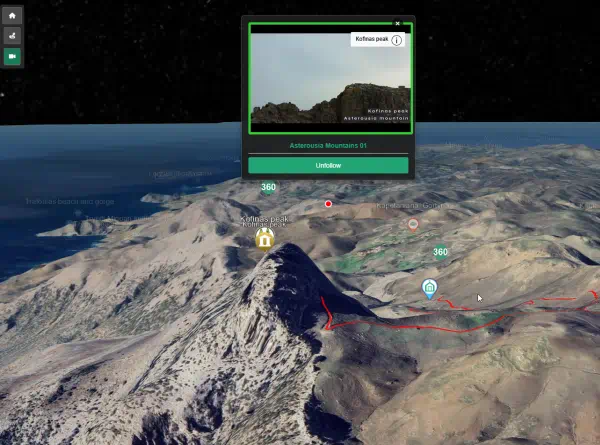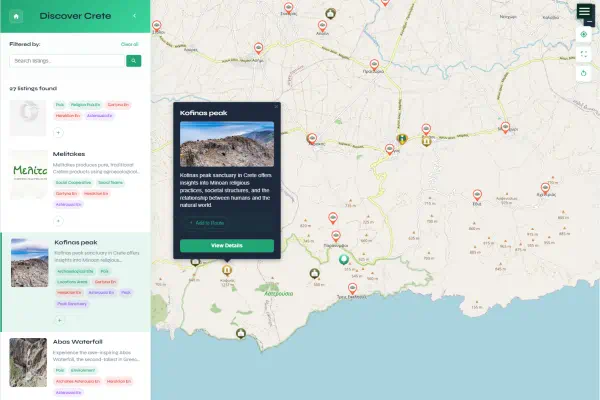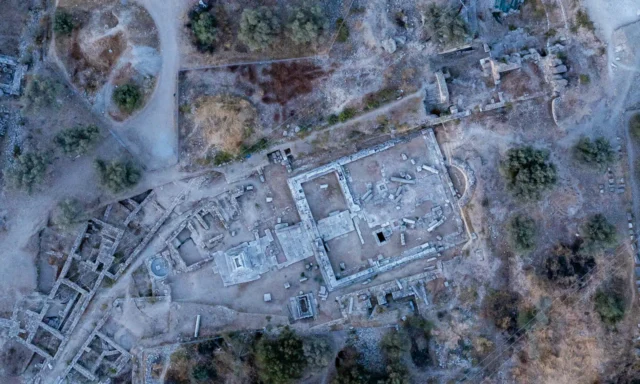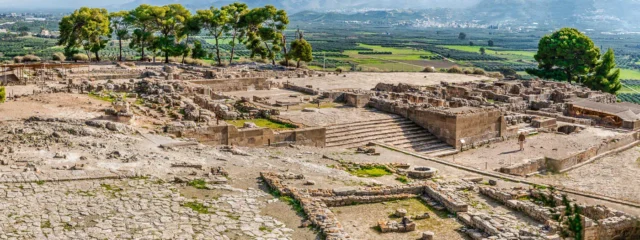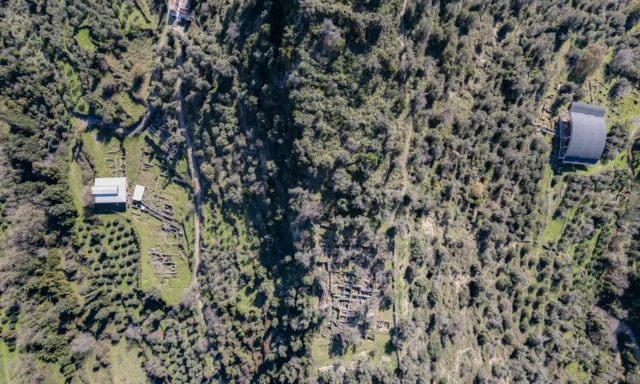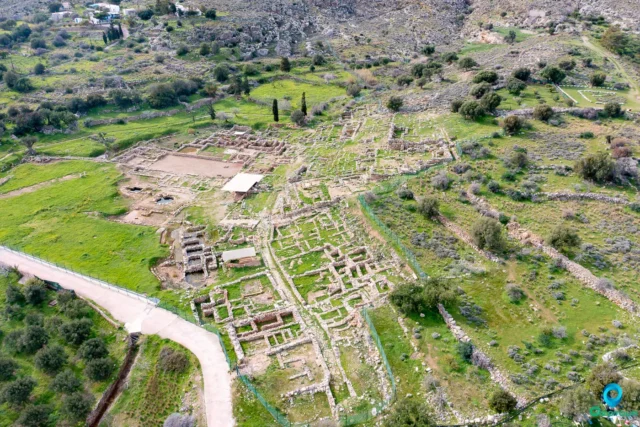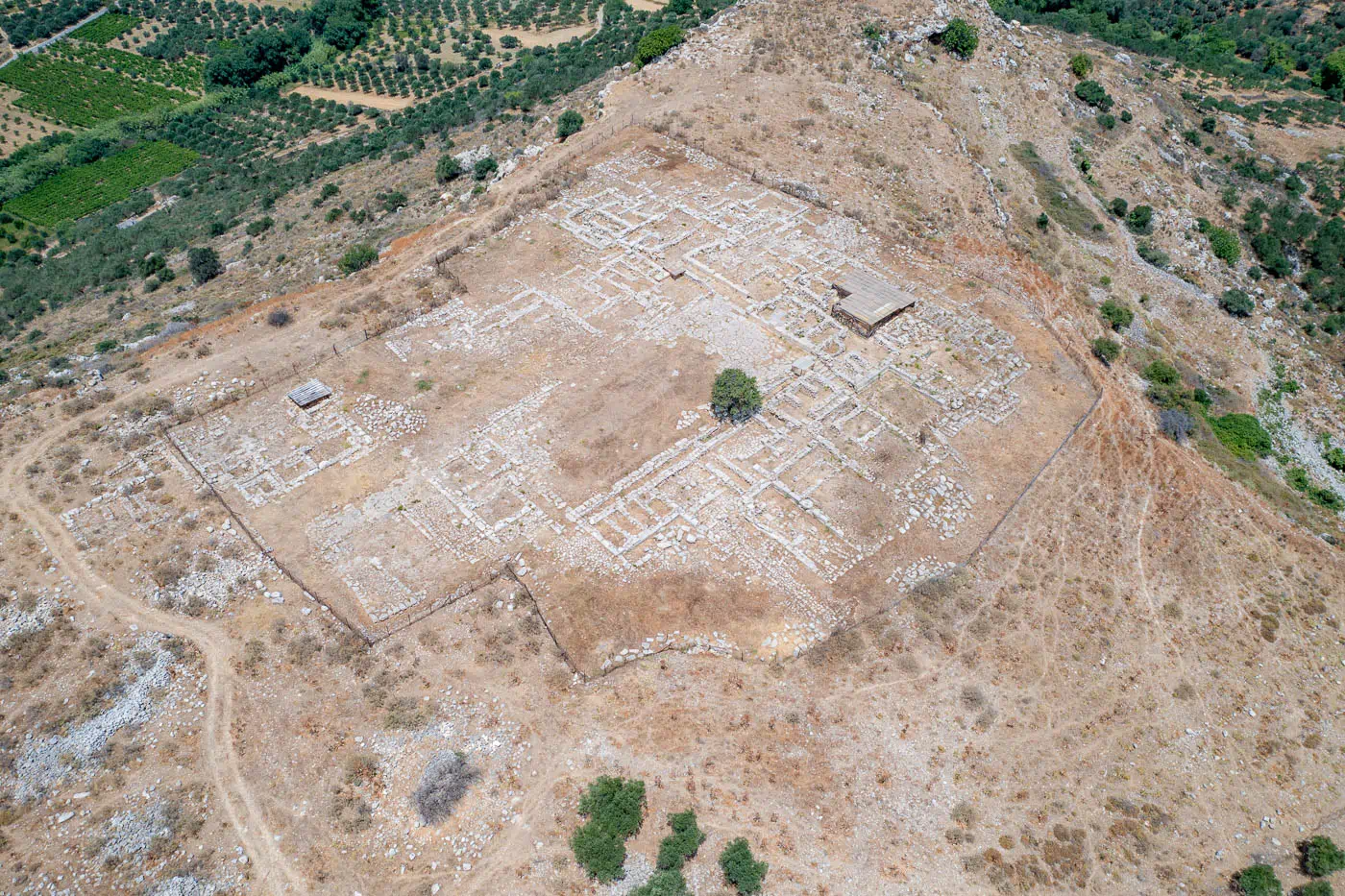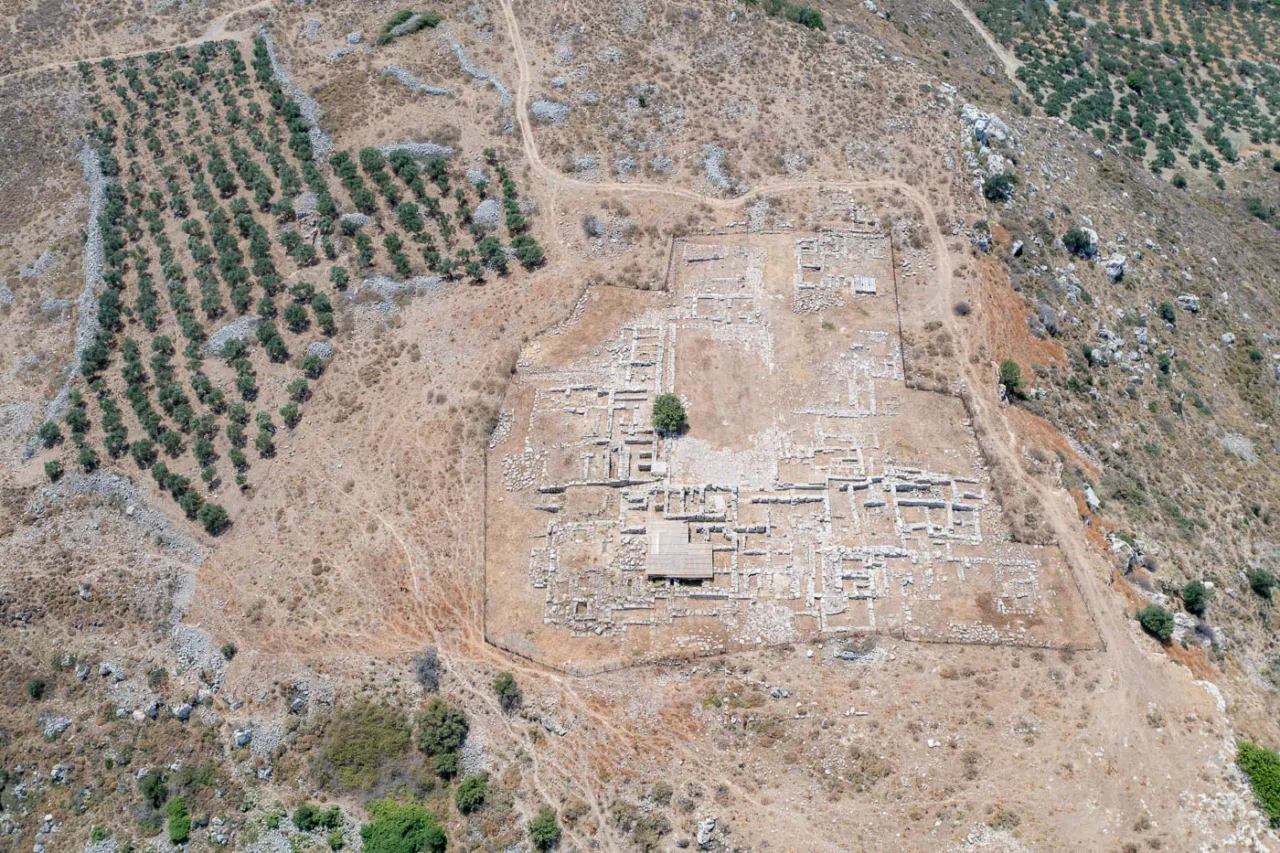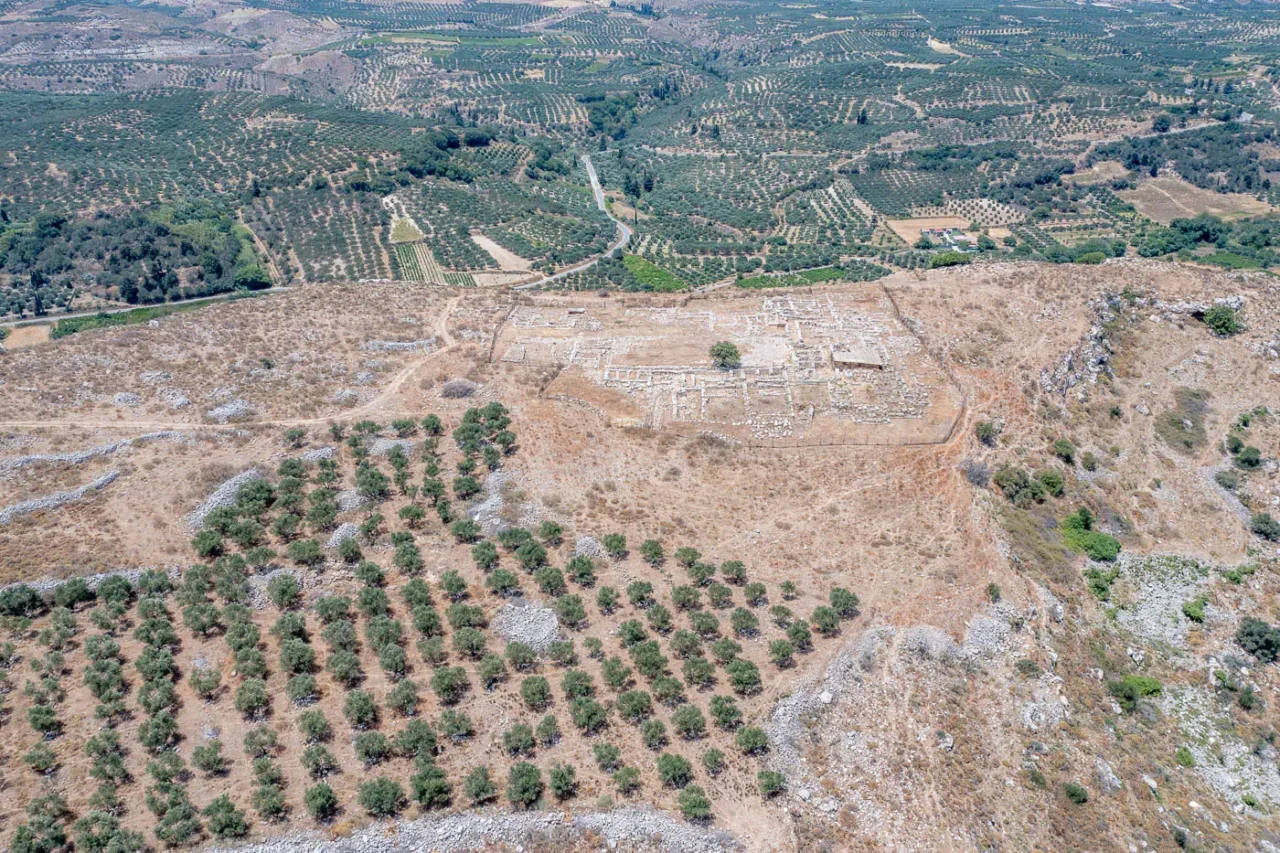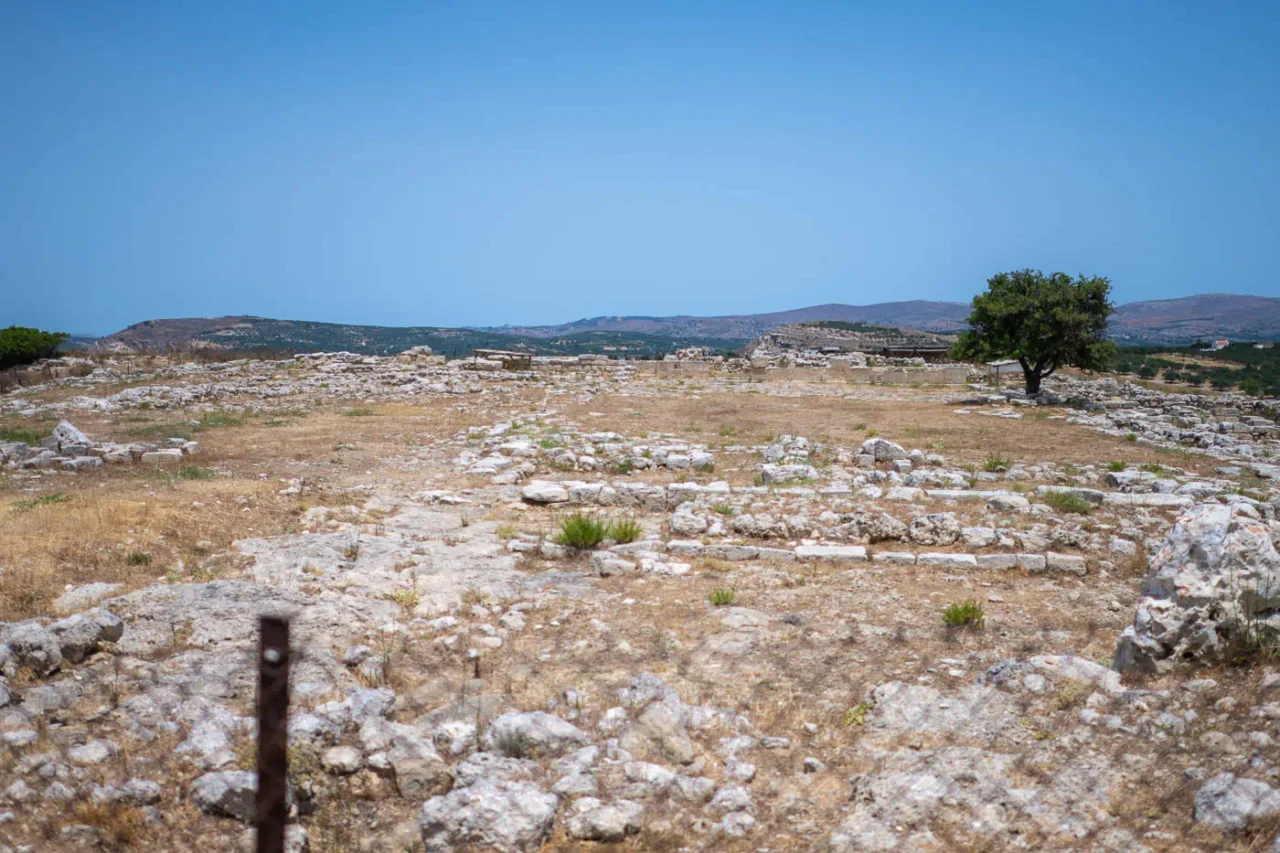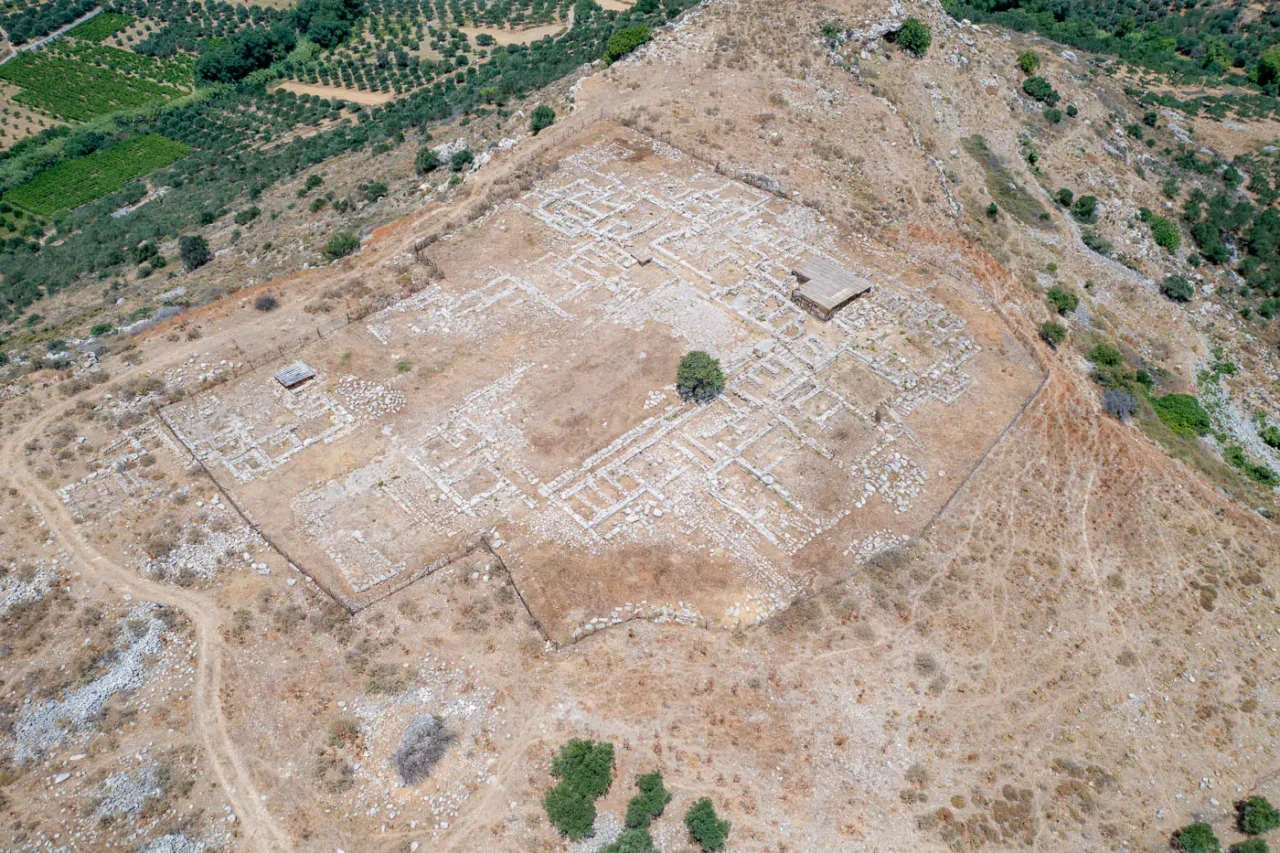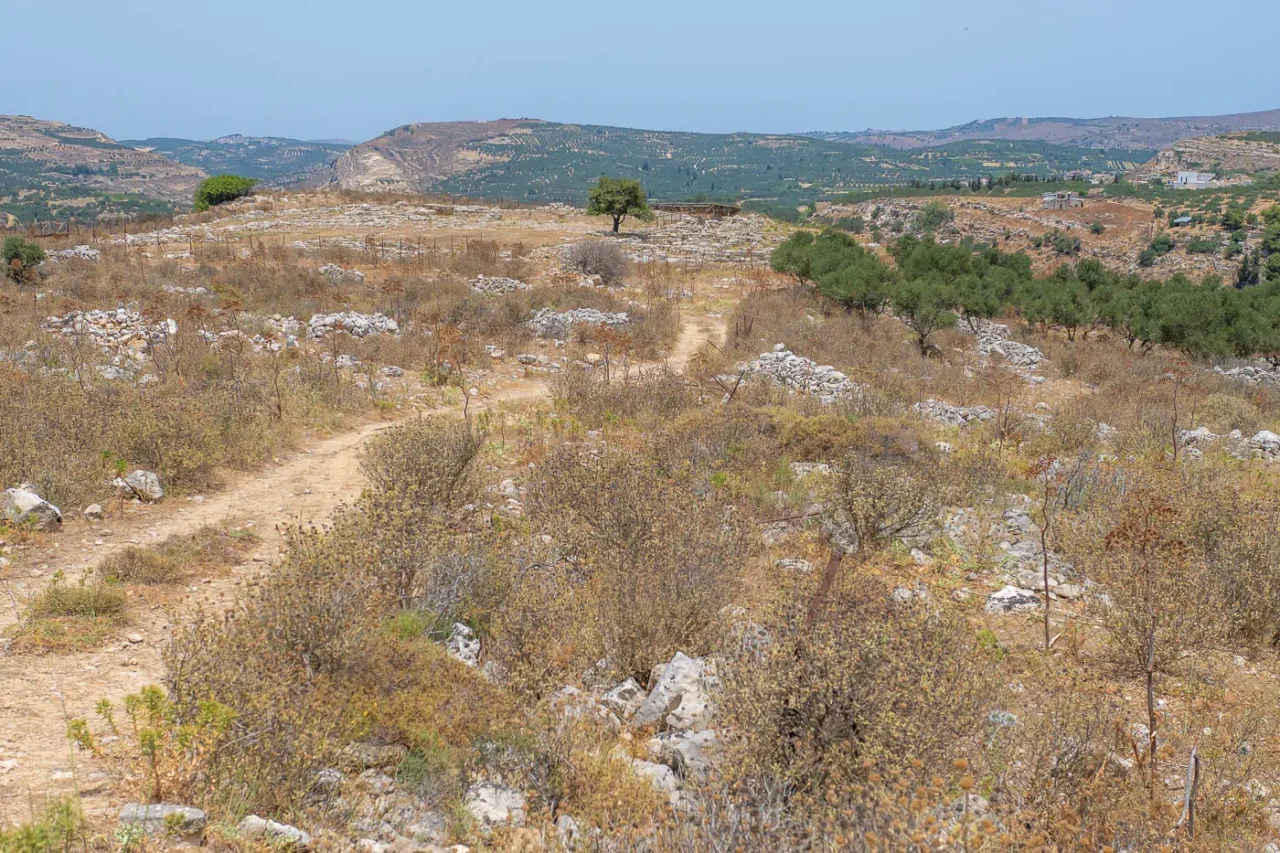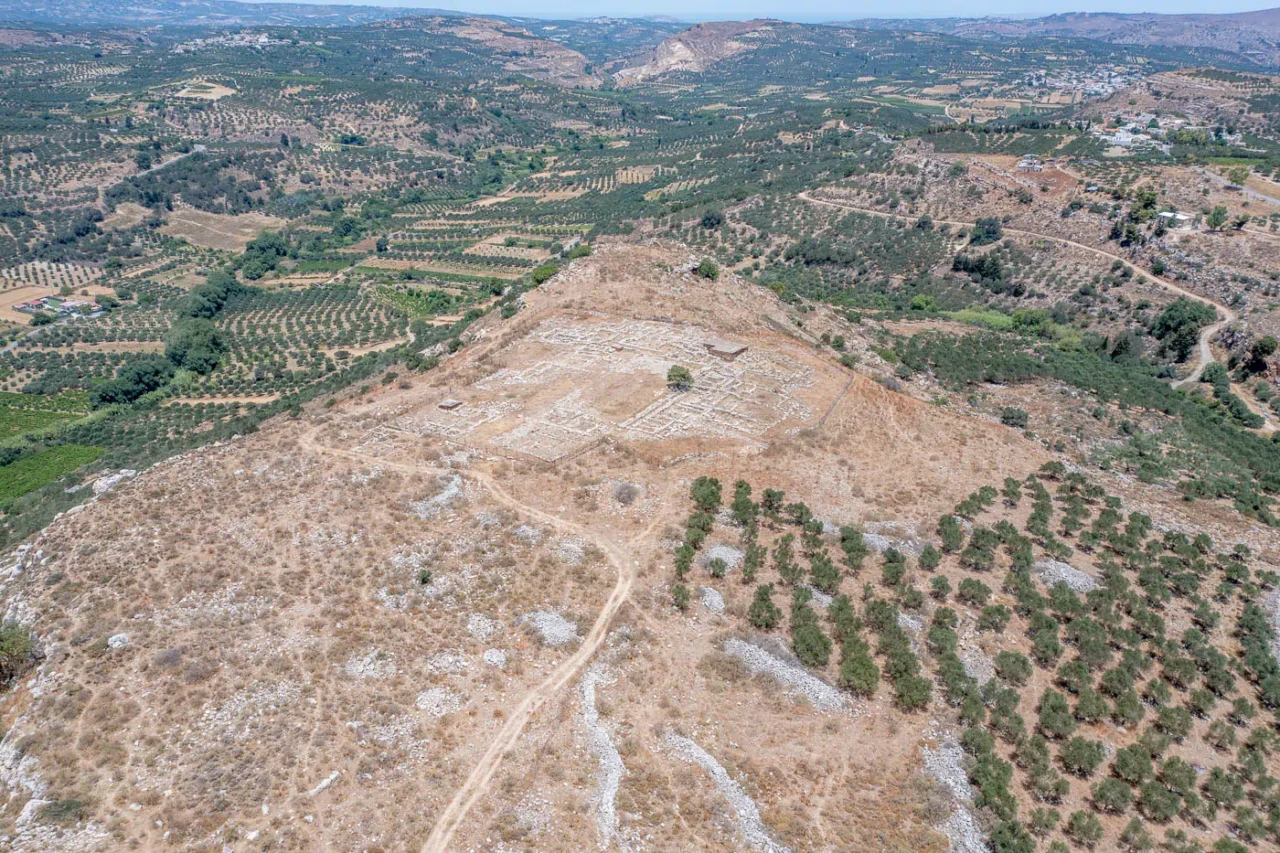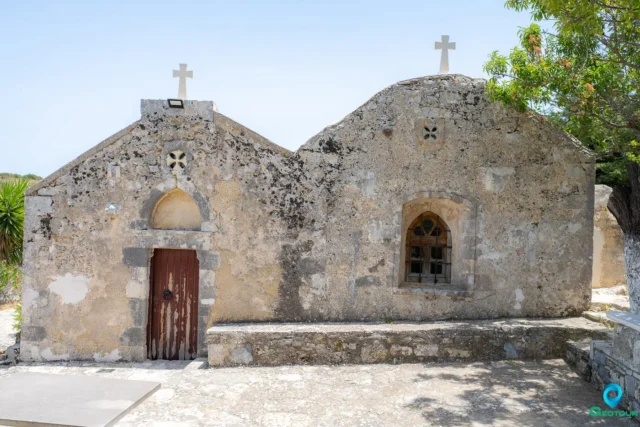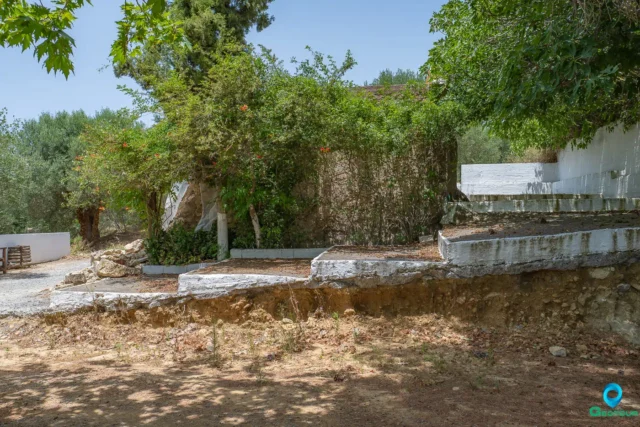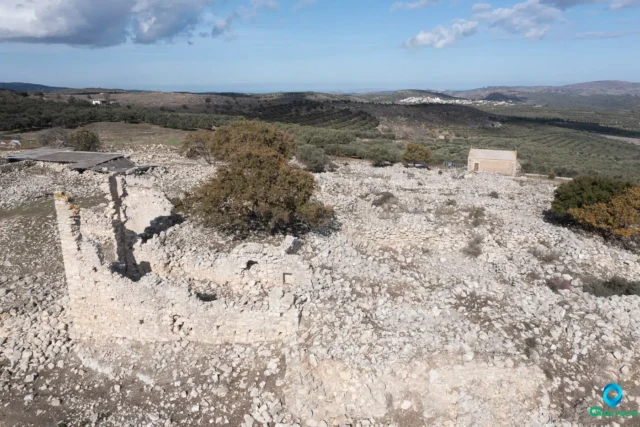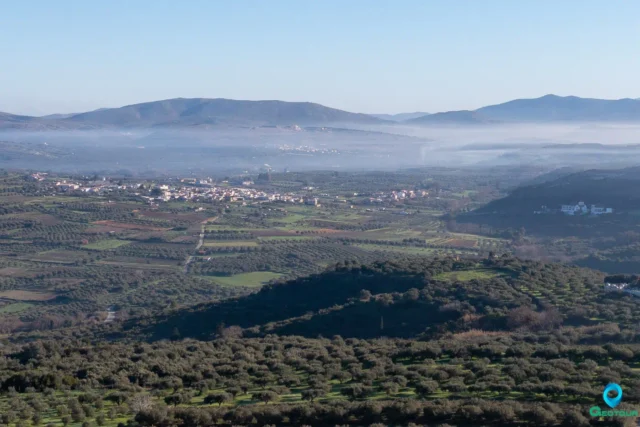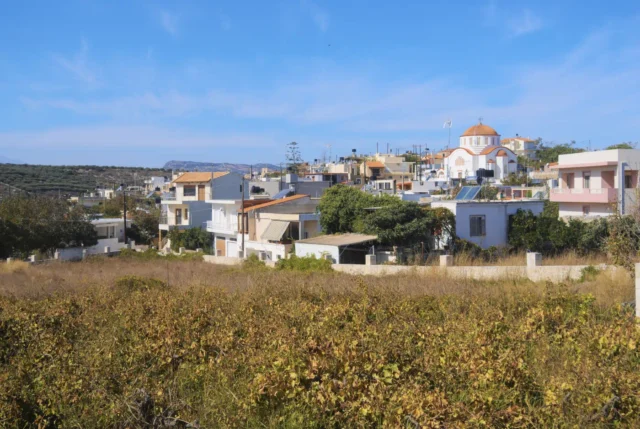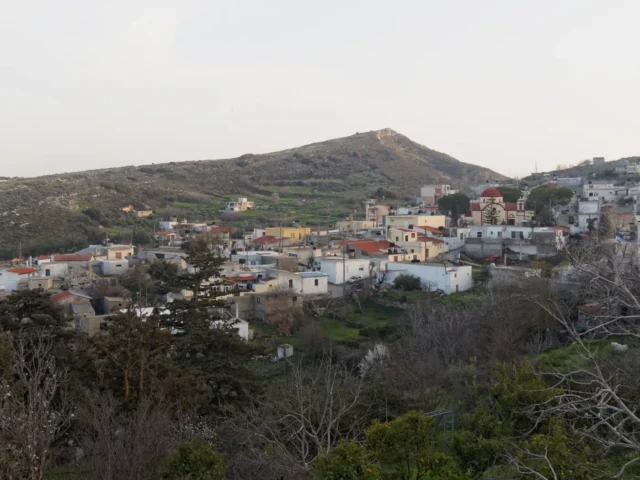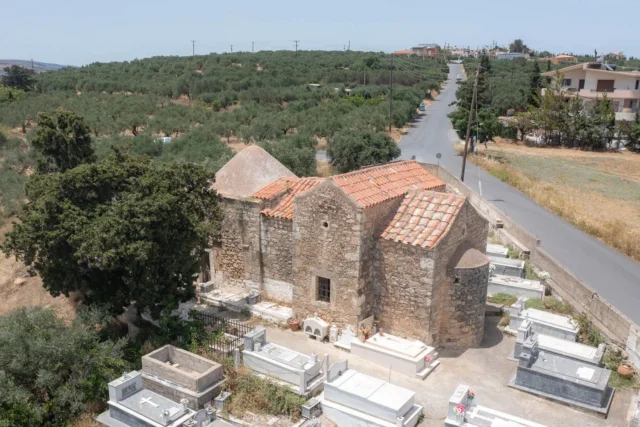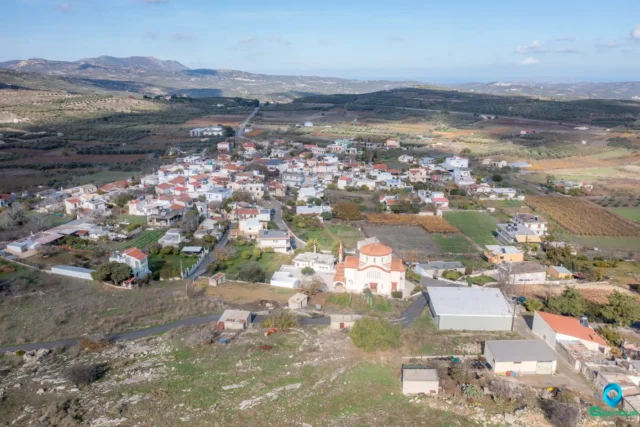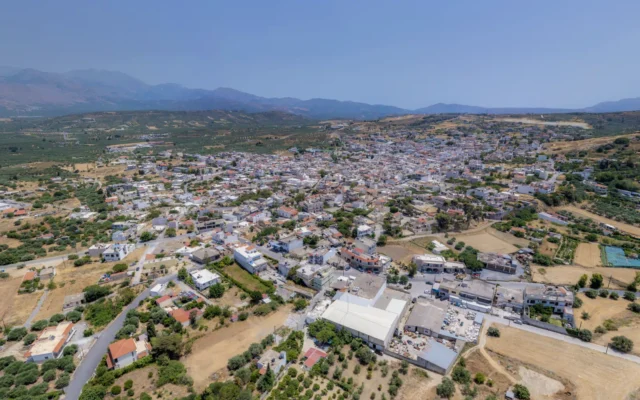Located in the Pediada region of central Crete. More specifically, on the Galatas Kephala.
Galatas is a significant Minoan urban site with a palace complex that was occupied from at least the Early Minoan I period through the Late Minoan III period, with periods of abandonment and rebuilding. The palace, constructed during the Middle Minoan IIIA period and rebuilt in Middle Minoan IIIB, served as an administrative, economic, and ideological center for the city and the surrounding region. Archaeological investigations, including excavations and the Galatas Survey Project (G.S.P.), have revealed details about the settlement’s architecture, urban planning, economic activities, and its relationship with other Minoan centers, particularly Knossos.
Historical Periods
Early Stages of Occupation and the Emergence of Architecture
The Galatas Kephala holds evidence of a long history, with the earliest signs of people residing there traced back to the Early Minoan I period. This initial occupation during Early Minoan II indicates a very early connection to the land. However, it was not until the Middle Minoan IA period that the first recorded architectural remains appeared at the settlement. This marks a significant shift from earlier, less substantial forms of habitation to the construction of more permanent structures, suggesting the beginnings of a settled community. The subsequent Middle Minoan IB period witnessed a continuation of this trend, with ongoing occupation and further development of the settlement. This suggests a period of growth and consolidation as the community took root and expanded upon the initial architectural foundations.
The Zenith of the Settlement
The settlement at Galatas likely reached its height during the Middle Minoan IIIB period. Following a period of rebuilding after a significant destruction, this phase appears to represent the peak of its size and importance. Intensive survey work conducted at the site supports the idea that the settlement achieved its largest extent during this time. The palace and elite buildings, having been reconstructed, were fully occupied, possibly reflecting a period of stability and prosperity. The architectural style and building materials employed during this rebuilding phase also demonstrated continued links to Knossos, hinting at broader cultural and possibly political connections that may have contributed to the settlement’s prominence.
A Period of Destruction and Rebuilding
Toward the end of the Middle Minoan IIIA period, a significant destructive event occurred at Galatas. The palace complex and the elite buildings that had been constructed as part of an extensive building program were partly ravaged by an earthquake, which was then followed by a fire. This event caused considerable damage and disruption to the settlement. However, this destruction was not the end of Galatas‘s prosperity. The subsequent Middle Minoan IIIB period saw a determined effort to rebuild the damaged structures, including both the palace and the elite residences. This rapid reoccupation and rebuilding underscore the resilience and continued importance of Galatas within the regional landscape.
Eventual Abandonment
Despite periods of prosperity and rebuilding, the town of Galatas was eventually abandoned sometime during the Late Minoan III period. Following the Middle Minoan IIIB peak and the subsequent Late Minoan IA where parts of the settlement remained in use, the site continued to be occupied into the Late Minoan IB period. Notably, towards the end of this latter phase, a specific building within the settlement was utilized as a workshop for processing agricultural products and weaving, indicating continued economic activity. However, this period also concluded with a destructive fire that affected all the buildings. While some limited reoccupation or activity might have occurred, the town did not persist, and by the Late Minoan III period, Galatas was ultimately deserted. The reasons for this final abandonment are not explicitly detailed in the provided information, but the cumulative effects of destructions and shifting regional dynamics likely played a role.
[/bt_bb_text]
Archaeological Discoveries
Excavations and Survey at Galatas
The Minoan settlement at Galatas, situated inland in central Crete within the Pediada region, has been the focus of sustained archaeological investigation, most notably under the continuous direction of G. Rethemiotakis since 1992. These dedicated excavation efforts have been crucial in revealing the site’s complex stratigraphic sequence and shedding light on its occupation from the Early Minoan (EM) period through to its eventual abandonment in the Late Minoan (LM) III period. Complementing the intensive excavation work, the Galatas Survey Project (G.S.P.) has played a vital role in broadening our understanding of the site by exploring its wider hinterlands. The data gathered from the surface survey has provided a more comprehensive picture of the settlement’s extent, particularly during its peak in the Middle Minoan (MM) IIIA-B periods, when it may have covered an area of approximately 25 hectares. Furthermore, contributions from investigations conducted by Evely et al. and Morgan, Pitt, and Whitelaw have further enriched the body of knowledge concerning Galatas and its development. These combined efforts of excavation and regional survey offer invaluable insights into the urban planning, architecture, and material culture of this significant Minoan center.
Revealing Daily Life and Ritual: Notable Artifactual Finds
The archaeological excavations at Galatas have yielded a diverse array of artifacts that provide glimpses into the daily lives, economic activities, and ritual practices of its inhabitants. Among the notable discoveries is a shrine model. Although the specific details of this model and its precise dating within the long occupational history of the site are not fully elaborated in the provided sources, the presence of such an object suggests the existence of religious or cultic activities within the community, consistent with evidence from other Minoan sites where similar models have been found in both Prepalatial and later contexts.
Further evidence hinting at administrative functions comes from the discovery of a Linear A tablet in the area of the Royal Villa at Agia Triada. While not directly found at Galatas, this discovery is significant as Galatas is recognized as a minor palace site during the Second Palace period (ca. 1700-1450 BCE). The Linear A script was used for administrative purposes, and its presence at a site contemporary with Galatas suggests that similar record-keeping and administrative activities may have also taken place at Galatas.
Fragments of miniature pictorial frescoes have also been unearthed at Galatas, depicting landscape scenes characterized by red wavy terrain lines, stylized rocks, and floral arrangements. These delicate finds, discovered in MM IIIA deposits within the eastern wing of the palace and in House 1, offer a glimpse into the artistic expressions of the Minoans at Galatas. Notably, Rethemiotakis suggests that stylistic affinities with later frescoes from Knossos indicate that the Galatas frescoes may have been created by painters trained at the prominent Knossian center, highlighting potential artistic connections between the two sites.
The discovery of stone drill guides at several locations within the Galatas settlement, as well as at nearby sites like Melissokopa, points towards the production of stone vessels in the area. Stone vases were often considered prestige objects due to the skill and time required for their manufacture. The presence of these drill guides suggests that Galatas itself, possibly within the palace or at designated workshops, was involved in this craft, and that stone vessel production may not have been solely controlled by the palatial center, with evidence indicating production at more distant settlements as well.
Evidence for storage is apparent in the archaeological record through the discovery of amphorae and pithoid jars. Within the palatial complex, an area of approximately 80.5 square meters was dedicated to the storage of consumable products such as olive oil, wine, cereals, and other agricultural goods, likely collected as taxes from the surrounding hinterlands. The presence of these storage vessels underscores the economic role of the palace as a center for the collection and redistribution of resources.
Deposits containing drinking and eating vessels have also been found, particularly in areas associated with the palace, such as the eastern projection of the northern wing, close to the Minoan Hall complex. These finds, often associated with large quantities of animal bones and other food remains, strongly suggest the occurrence of feasting and communal dining events within the palatial setting. Such events likely played a role in social differentiation and the reinforcement of social cohesion among the elite.
Finally, the study of Late Minoan I (LM I) pottery groups from both the palace and the town provides crucial chronological and contextual information about the later phases of occupation at Galatas, allowing researchers to track changes in material culture and settlement patterns leading up to the site’s eventual abandonment.
Traces of Monumentality and Planning: Remarkable Architectural Discoveries
The architectural remains unearthed at Galatas reveal a sophisticated and well-organized settlement, dominated by a substantial palatial complex. This palace, constructed in the Middle Minoan IIIA period as part of a unified building program, consisted of four wings arranged around a central courtyard, occupying an area of nearly one hectare. The palace served multiple functions, providing spaces for storage, ceremonial activities, and industry, reflecting its central role in the political, economic, and ideological life of the city and the surrounding region.
Surrounding this monumental core were a number of large, freestanding structures, including Buildings 1, 3, 5, 6, and 7. These buildings exhibited architectural elaborations that distinguished them, such as the use of carefully cut ashlar masonry, remnants of wall paintings, and specialized rooms like Minoan Halls. The presence of Minoan Halls, characterized by their distinctive architectural features and often elaborate decoration, suggests that these structures may have served as elite residences or spaces for important social and ceremonial functions.
A significant aspect of the urban layout at Galatas is the consistent north-south orientation shared by the palace and many other urban features. This deliberate alignment, with the central courtyard of the palace serving as a primary organizing element, indicates a degree of intentional planning in the settlement’s design. A major street is believed to have run north-south along the Kephala, the long ridge upon which Galatas was built, extending through the settlement and leading up to the palace, facilitating movement and access within the urban space.
The construction of the palace at Galatas involved significant engineering efforts, evidenced by the extensive system of terrace walls, particularly prominent on the northern and eastern wings. These retaining structures were necessary to create suitable building space on the sloping terrain and represent a considerable investment of labor and materials.
The choice of building materials further underscores the sophistication and potential external connections of Galatas. Limestone ashlar blocks, used extensively in the palace’s exterior walls, main feasting and reception areas, and residential halls, were quarried from Alagni, approximately 4 kilometers away. The transportation of this stone indicates a significant undertaking and suggests a level of organization and resource mobilization. Additionally, gypsum, sourced from an outcrop 13 kilometers distant, was utilized for door jambs and pillar bases in important spaces like the Pillar Hall, Columnar Hall, and Minoan Hall, highlighting the use of specialized and possibly prestige materials, also found at Knossos. Elaborately paved floors in select areas of the palace further attest to the attention to detail and monumental character of the architecture.
Finally, the discovery of a large, rectangular building that functioned as a workshop for agricultural processing and weaving at the end of the Late Minoan IB period provides valuable insight into the economic activities taking place at Galatas during its later occupation. This specialized structure indicates a continuation of settlement activity and a focus on practical crafts even as the palatial functions began to diminish.
Cultural and Economic Context
Cultural Connections and External Influences Shaping Galatas
The archaeological record at Galatas reveals a settlement deeply intertwined with the broader cultural landscape of Minoan Crete, exhibiting particularly strong connections to the prominent center of Knossos. These links are evident across various aspects of the site, from architectural design and the sourcing of specific building materials to potential political and ideological influences. The abrupt emergence of palatial architecture at Galatas during the Middle Minoan IIIA period, characterized by design elements reminiscent of Knossos, strongly suggests the imposition of a new sociopolitical order closely affiliated with the Knossian realm. This architectural transformation, including the use of gypsum sourced from the Knossian area, points towards a significant degree of interaction, potentially involving the direct involvement of Knossian workmen in the construction of the palace. The presence of mason’s marks on ashlar blocks at Galatas that are similar to those found at Knossos further reinforces this possibility.
When considering Galatas within the wider context of Minoan urbanism, it is recognized as one of approximately two dozen settlements that possess characteristics warranting the designation of ‘urban’. Comparisons with other significant Minoan centers such as Knossos, Malia, Phaistos, Zakros, Gournia, and Petras highlight shared underlying concepts in urban planning, including the presence of a central palatial complex, a degree of spatial organization, and the existence of public or communal spaces. The coordinated north-south orientation observed in the palace and other urban features at Galatas aligns with a pattern seen in other Minoan palatial sites, suggesting adherence to certain standardized principles of layout and design. Furthermore, the concept of a tripartite urban hierarchy, with larger administrative centers and smaller towns fulfilling specialized roles, as proposed for Minoan Crete, potentially positions Galatas as a significant center within its regional context. The survey data suggests a three-tiered settlement hierarchy in the Galatas area during the Neopalatial period, with Galatiani Kephala (the location of the Galatas palace) at the apex.
The nearby settlement of Kastelli also appears to have played a role in the sociopolitical landscape of the Pediada region. Evidence suggests that Kastelli may have functioned as a second-order center influencing the Galatas area, potentially even replacing Galatiani Kephala in importance by the Late Minoan IA period. This suggests a dynamic relationship between different centers within the region and highlights the complexity of the political geography.
Economic Activities Sustaining the Galatas Community
The archaeological evidence from Galatas provides insights into a diverse range of economic activities that underpinned the settlement’s existence. Agricultural production and processing were undoubtedly significant, as evidenced by the large, rectangular building identified as a workshop for these purposes at the end of the Late Minoan IB period. This structure indicates a focus on the preparation of agricultural products, likely contributing to the sustenance of the population and potentially for the purposes of storage and redistribution by the palatial center.
The discovery of stone drill guides within the settlement suggests that Galatas was also involved in the production of stone vessels. This craft, often associated with prestige goods in Minoan society, indicates a level of specialized artisanal activity at the site. While the palace at Galatas may not have exclusively controlled this industry, the presence of these tools points to local production, potentially contributing to both local consumption and exchange networks.
Textile production is another economic activity attested at Galatas, again with evidence of a weaving workshop in the Late Minoan IB period. While the major palaces like Knossos, Malia, and Phaistos are not characterized by extensive in-palace weaving installations during the Second Palace period, textile production appears to have been a significant household-level activity and a feature of smaller palatial sites and villas such as Ayia Triada and Archanes. The palace at Galatas likely served as a consumer of textiles, which were important items for display and ceremonial use, as well as potential trade goods. The existence of a dedicated weaving workshop within the town indicates that textile-related activities were a notable aspect of the local economy.
Feasting played a significant role in the social and potentially political life of Galatas. The presence of deposits containing drinking and eating vessels, along with faunal remains in proximity to the palace [various], strongly suggests communal dining events. These feasting activities, often linked to ritual and the reinforcement of social cohesion among different groups within the community, were likely organized and sponsored by the palatial authorities. The storage capacity within the palace for commodities like olive oil, wine, and cereals further supports the notion that the palace played a central role in organizing and provisioning these large-scale gatherings.
Cultural Practices Reflected in the Archaeological Record
The cultural practices of the inhabitants of Galatas are illuminated by the various archaeological discoveries. Ritualistic activities are suggested by the presence of a shrine model, indicating the existence of religious or cultic practices within the community [various]. Feasting itself likely held cultural significance, potentially intertwined with religious ceremonies and serving as a key mechanism for social interaction, the display of status, and the fostering of group identity. The discovery of the baetyl in the southern courtyard of the palace further supports the notion of ritual practices associated with specific architectural spaces.
The planned nature of the city of Galatas provides crucial insights into its social organization and the deliberate use of the built environment to communicate social and political messages. The coordinated north-south orientation of buildings with respect to the palace’s central courtyard suggests a hierarchical structure with the palatial elite at the center of social and political life. The potential existence of distinct districts within the city, although not yet fully understood due to the focus of excavations on the monumental core, hints at a degree of social differentiation and organization within the urban space.
Architectural monumentality at Galatas, exemplified by the substantial palatial complex, the use of ashlar masonry, wall paintings, and elaborately paved floors, served as a powerful visual statement of the wealth and authority of the central powers, likely linked to Knossos. The investment of significant labor and resources in these monumental constructions underscores their importance in projecting the social and political standing of the ruling elite. The standardization observed in certain architectural features across Minoan sites, including Galatas, further suggests a shared cultural koine and potentially the influence of central planning or overarching ideologies.
Key Points
- Location and Accessibility: Located in the Pediada region of central Crete, on the Galatas Kephala.
- Dimensions: The palace complex occupied nearly 1 hectare. The overall size of the urban settlement is estimated to have been significant during its peak in MM IIIB.
- Active Historical Periods: Primarily active from Middle Minoan IA to Late Minoan IB, with earlier (EM I-II) and later (LM III) presence. The palace phases are mainly MM IIIA and MM IIIB.
- Historical Significance: A major Minoan urban center with a palatial complex that demonstrates planned construction, strong connections to Knossos, and a role as an administrative, economic, and possibly religious hub in the Pediada region.
- Current Status: An active archaeological site under continuous excavation and study, contributing significantly to our knowledge of Minoan Crete.
References
- D. Matthew Buel, 2015. Minoan Cityscapes: Urban Planning in Neopalatial Crete.
- D. Matthew Buell, 2017. Building a Minoan State at Neopalatial Galatas, in: The Galatas Survey: The Socio-Economic and Political Development of a Contested Territory in Central Crete during the Neolithic to Ottoman Periods. INSTAP Academic Press (Institute for Aegean Prehistory), pp. 55–77. https://doi.org/10.2307/j.ctt1wrpwkj
- D. Matthew Buell, 2014. The Rise of a Minoan City and the (Re)Structuring of Its Hinterland: A View from Galatas, in: Fisher, K.D., Creekmore, A. (Eds.), Making Ancient Cities: Space and Place in Early Urban Societies. Cambridge University Press, New York, NY.
- Georgios Rethemiotakis, 2010. A shrine-model from Galatas. British School at Athens Studies Vol. 18, CRETAN OFFERINGS: Studies in honour of Peter Warren (2010), 293-302 (10 pages).
- Keith Branigan, 2001. Aspects of Minoan Urbanism – 2001 – Urbanism in the Aegean Bronze Age, in: Keith Branigan (Ed.), Urbanism in the Aegean Bronze Age. pp. 39–50.
- Pietro Militello, 2008. Textile Industry and Minoan Palaces, in: Gillis, C., Nosch, M.-L.B. (Eds.), Ancient Textiles: Production, Craft and Society Proceedings of the First International Conference on Ancient Textiles, Held at Lund, Sweden, and Copenhagen, Denmark, on March 19-23, 2003, Ancient Textiles Series. Oxbow Books, Oxford.

